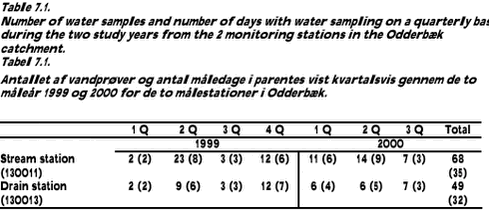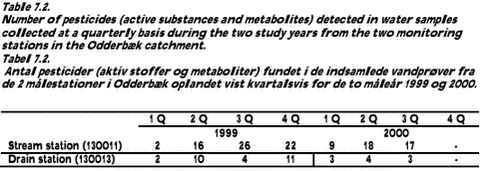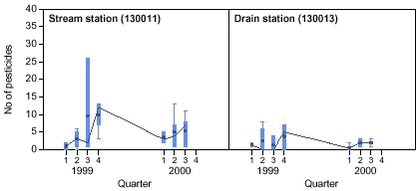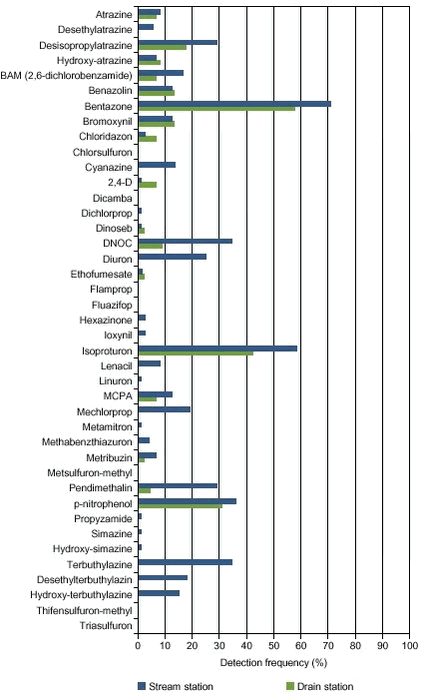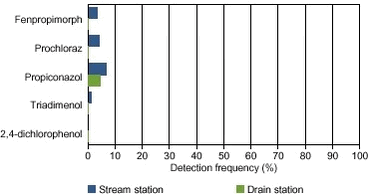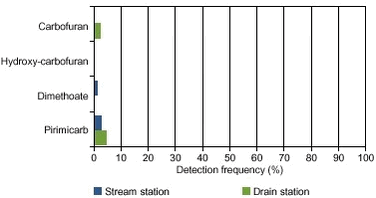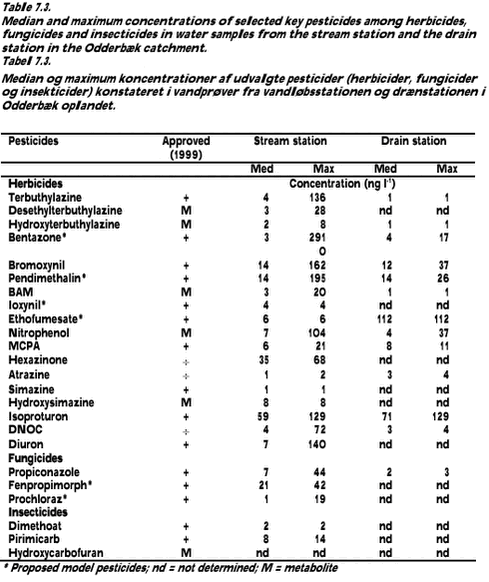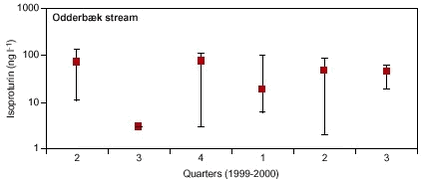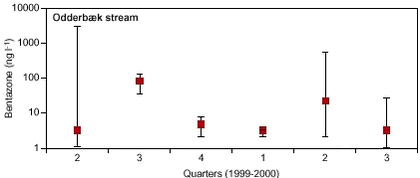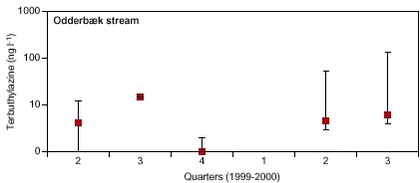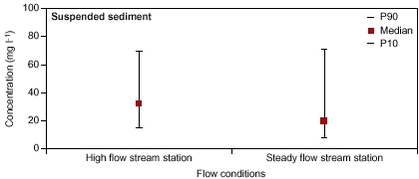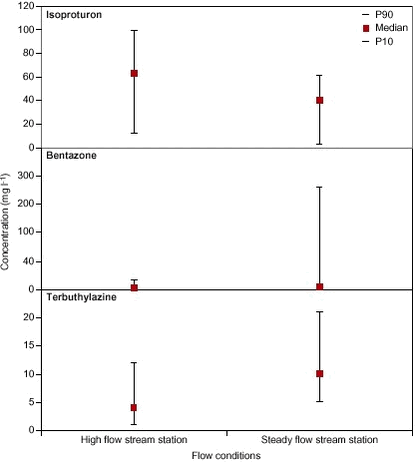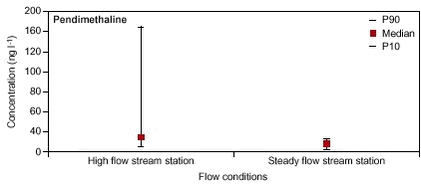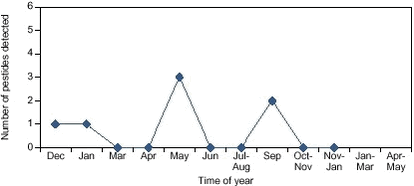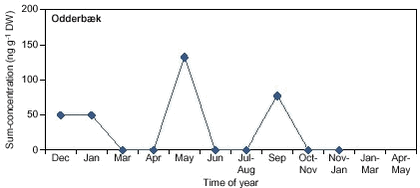Pesticides in streams and subsurface drainage water within two arable catchments in Denmark: Pesticide application, concentration, transport and fate7 Pesticide occurrence and concentration in stream and drains in the Odderbæk catchment7.1 Water and sediment samples collected from the monitoring stations in the Odderbæk catchment7.2 Detection of pesticides in stream and subsurface tile drainage water 7.3 Key pesticides detected in stream and drainage water 7.4 Pesticides in suspended sediment 7.5 Pesticides in streambed sediment 7.1 Water and sediment samples collected from the monitoring stations in the Odderbæk catchmentTable 7.1 shows the number of days with water sampling and number of water samples analysed for pesticides in the Odderbæk catchment. Water samples were collected from the two monitoring stations during both sampling years on sampling dates shown in Figure 7.1. A total of 68 water samples were collected from the stream station and 49 water samples from the drain station. A total of 24 water samples were collected during storm events, whereas 13 water samples were collected during periods with steady or decreasing discharge conditions at the Odderbæk stream station (Fig. 7.1).
Suspended sediment was collected with an in situ sampler (SubMarie) from the stream stations during the second study year. A total of nine suspended sediment samples were collected from the stream station during the period December 1999 - November 2000. Three streambed sediment samples were collected during three surveys in the first study year (March, June and May 1999) and another three sediment samples were collected during three surveys in the second study year (May and June 2000). 7.2 Detection of pesticides in stream and subsurface tile drainage waterForty-nine different pesticides and metabolites were analysed in the water samples collected from stream and subsurface tile drainage water. In total, 39 different pesticides were detected at the stream station and 27 at the drain station in the Odderbæk during the 2-year study period. The number of pesticides detected in subsurface drainage water was somewhat lower than from the catchment as a whole (Table 7.2). The number of pesticides detected varied between the different seasons of the study years but were in general higher during the quarters with pesticide application 2nd, 3rd and 4th quarter (Table 7.2). However, part of this variation can possibly be explained by a varying number of water samples being collected during each quarter (Table 7.1).
A descriptive statistics for the number of pesticides detected per water sample in each quarter of the two study years is shown in Figure 7.2. The number of pesticides in water samples generally increases throughout the seasons of the year, being on average highest in the 4th quarter and lowest in the 1st quarter at the stream and drain station (Fig. 7.2). Moreover, the number of pesticides detected in water samples was generally higher in the wet year of 1999 than in the drier year of 2000.
The detection frequency for herbicides recovered at the two stations in the Odderbæk catchment is shown in Figure 7.3. The highest detection frequencies were generally found at the stream monitoring station as compared to the drain station. In many cases the herbicides were found in both stream and subsurface drainage water and for some herbicides also at comparable detection frequencies (isoproturon, bentazone).
The ten most common herbicides detected in the samples from the stream station were bentazone (70.8%), isoproturon (58.3%), nitrophenol (36.1%), DNOC (34.7%), terbuthylazin (34.7%) and metabolites (15.3-18.1%), pendimethalin (29.2%), desisopropylatrazine (29.2%), diuron (25%) and mechorprop (19.4%) (Fig. 7.2). In comparison, the ten herbicides with highest detection frequencies in drainage water were bentazone (57.8%), isoproturon (42.2%), nitrophenol (31.1%), desisopropylatrazine (17.8%), benazolin (13.3%), bromoxynil (13.3%), hydroxyatrazin (8.2%), BAM (6.7%), mechlorprop (6.7%) and pendimethalin (4.4%), (Fig. 7.3). Four of the five fungicides analysed for in water samples were detected in stream water and only one in subsurface drainage water (Fig. 7.4). The detection frequency was, however, considerably lower than for many of the herbicides (Fig. 7.4). The detection frequency was nearly equally low in stream and drainage water, being below 10% for all fungicides (Fig. 7.4).
Two of the three insecticides analysed for in water samples were detected in stream water and two insecticides in drainage water (Fig. 7.5). The detection frequency for insecticides was lower than for most of the herbicides and fungicides analysed for in the same water samples, being below 5% in all cases (Fig. 7.5).
Nineteen pesticides and five metabolites were detected at both monitoring stations and of these ten pesticides were applied in the catchment during the two study years. Pesticides not applied during the two study years were atrazine, 2,4-D, diuron, dinoseb, mechlorprop, DNOC and nitrophenol, many of them being banned in Denmark for several years. The somewhat high detection frequency of DNOC and nitrophenol at both sampling stations can, however, be attributable to emissions from traffic. The median and maximum pesticide concentrations measured at the stream and drain station in the Odderbæk catchment are shown in Table 7.3 for selected key pesticides from the three groups of herbicides, fungicides and insecticides. The median and maximum concentrations for all pesticides analysed for in water samples from the stream and drain station can be found in Appendix 7.1. The number of pesticides measured in concentrations exceeding 100 ng l-1 at the stream station in the Odderbæk catchment (seven pesticides) was higher as compared to the drain station (two pesticides). The 10 pesticides and metabolites detected in highest maximum concentrations at the stream station were bentazone (2910 ng l-1), pendimethalin (195 ng l-1), bromoxynil (162 ng l-1), diuron (140 ng l-1), terbuthylazine (136 ng l-1), isoproturon (129 ng l-1), nitrophenol (104 ng l-1), DNOC (72 ng l-1), cyanazin (68 ng l-1) and hexazinon (68 ng l-1). The similar findings for the drain station were isoproturon (129 ng l-1), ethofumesate (112 ng l-1), chloridazone (43 ng l-1), bromoxynil (37 ng l-1), nitrophenol (37 ng l-1), pendimethalin (26 ng l-1), 2,4-D (26 ng l-1), bentazone (17 ng l-1), metribuzin (12 ng l-1) and MCPA (11 ng l-1). Five of the pesticides detected in highest maximum concentrations were similar at the stream and drain station. However, the maximum concentration of pesticides was exceedingly higher in stream water than in tile drainage water. Seven of the pesticides were detected in more than 25% of the water samples at the stream station in the Odderbæk catchment (Appendix 7.1). Of these seven pesticides the substances found most often at high concentrations as measured by the median concentration were isoproturon (59 ng l-1), pendimethalin (14 ng l-1), nitrophenol (7 ng l-1), DNOC (4 ng l-1) and terbuthylazine (4 ng l-1). Three of the pesticides were detected in more than 25% of the water samples at the drain station in the Odderbæk catchment (Appendix 7.1). Of these three pesticides the substances found most often at high concentrations as measured by the median concentration were isoproturon (71 ng l-1), bentazone (4 ng l-1) and nitrophenol (4 ng l-1). Isoproturon was the most frequently detected pesticide found at high concentrations at both the stream and drain station in the Odderbæk catchment. 7.3 Key pesticides detected in stream and drainage waterA number of key pesticides are selected for a more thorough presentation of their occurrence and concentration in Odderbæk during the study period. The selected pesticides represent six model pesticides chosen at an early stage of the project and other pesticides representing a combination of various active substances (herbicides, fungicides and insecticides) with different physico-chemical properties (see Table 6.4 in chapter 6). The median and the range in the concentration of isoproturon in the different quarters of 1999 and 2000 are shown in Figure 7.6 for the stream station in Odderbæk catchment. The herbicide isoproturon was applied to different crop types within the catchment during the 4th quarter of 1998, 2nd and 4th quarters of 1999 and 3rd quarter of 2000, always in the highest quantities in the autumn. No clear seasonal trends in the concentration of isoproturon could be detected (Fig. 7.6). Moreover, no major impacts on the concentration of isoproturon in stream water during the periods with application could be seen. However, the median concentration of isoproturon was generally lowest in the 1st quarter of 2000, which was without application and experienced the highest discharge and hence dilution effects.
The median and the range in the concentration of bentazone in the different quarters of 1999 and 2000 are shown in Figure 7.7 for the stream station in the Odderbæk catchment. The herbicide bentazone was only applied to different crop types within the catchment during the 2nd quarters of 1999 and 2000. A clear seasonal trend was obeserved with the highest median and maximum concentrations of bentazone during the 2nd quarters of 1999 and 2000 and the 3rd quarter of 1999. The median and the range in the concentration of bentazone were lowest in the 1st quarter of 2000. The seasonal trend in the concentration of bentazone thus followed the trend in applications in the catchment.
The median and the range in the concentration of terbuthylazine in the different quarters of 1999 and 2000 are shown in Figure 7.8. The herbicide terbuthylazine was applied to different crop types within the catchment during the 2nd quarters of 1999 and 2000. No seasonal pattern was detected for terbuthylazine (Fig. 7.8). The median concentration of terbuthylazine was always very low. High maximum concentrations of terbuthylazine were, however, measured in the 2nd and 3rd quarters of 2000 (Fig. 7.8).
The median, 10 and 90 percentiles of the concentration of suspended sediment and key pesticides were calculated for days with more and less than 1 mm of precipitation. In this way, the measured concentrations of pesticides were dub-divided into periods with high and steady flow conditions at the stream station in the Odderbæk catchment during 2000. The number of water samples in the high-flow and low-flow data sets were 24 and 13, respectively. The concentration of suspended sediment was marginally higher during days with high-flow than during days with steady-flow conditions at the stream station in the Odderbæk catchment (Fig. 7.9). Relatively high suspended sediment concentrations prevailed, however, during steady or decreasing flow conditions.
The concentration of isoproturon revealed a higher median and maximum concentration during high-flow periods than during steady-flow periods at the stream station in the Odderbæk catchment (Fig. 7.10). This pattern proposes that isoproturone must be readily available in source areas for being delivered to stream water during the rainy periods. One possibility is leaching from the soil column to upper groundwater and hence also subsurface drainage water in the tile drained parts of the catchment. High concentrations of bentazone were, however, measured in the Odderbæk during steady-flow periods (Fig. 7.10). Such a pattern could indicate that the herbicide was lost to the stream channel via wind drift during application in the catchment. In the case of terbythylazine, no large differences could be seen as the concentration range during either flow pattern was very narrow (Fig. 7.10).
The opposite pattern can be seen for pendimethaline, which experiences the highest concentrations during rainy periods (Fig. 7.11). The sorption coefficient for pendimethalin is high (Kd=70) and hence pendimethaline is readily sorbed and delivered and transported with particulate matter.
7.4 Pesticides in suspended sedimentComposite suspended sediment samples were collected at a near monthly basis at the stream stations in Odderbæk with the SubMarie sampler (see chapter 4). The number of pesticides detected was one in two samples from December 1999 and January 2000 (Fig. 7.12). No pesticides were detected in suspended sediment sampled during March, April, July/August, October/November 2000 and November/January 2001, whereas three pesticides were detected in the sample from May 2000 and two pesticides in September 2000 (Fig. 7.12).
The sum-concentration of pesticides in suspended sediment was highest in the suspended sediment sampled during May 2000 and September 2000 (Fig. 7.13). The sum-concentration in the sediment sample from May 2000 was 132 ng g-1 DW and 77 ng g-1 DW in September 2000. Pendimethalin was measured at the highest concentration of 100 ng g-1 DW in suspended sediment from May 2000, followed by diuron (40 ng g-1 DW) in the suspended sediment sample from September. Pendimethalin was detected in three of the nine suspended sediment samples, whereas diuron was detected in two samples and terbuthylazine in one sample. Pesticides recovered above the detection limit in suspended sediment at the stream station in Odderbæk were DDE-p,p, diuron, pendimethalin and terbuthylazine.
7.5 Pesticides in streambed sedimentNone of the 17 pesticides analysed for in the five streambed sediment samples taken from the Odderbæk stream was measured above the detection limit. Sediment sampling was undertaken in April, June and August 1999 and May 15th and 29th 2000. |
